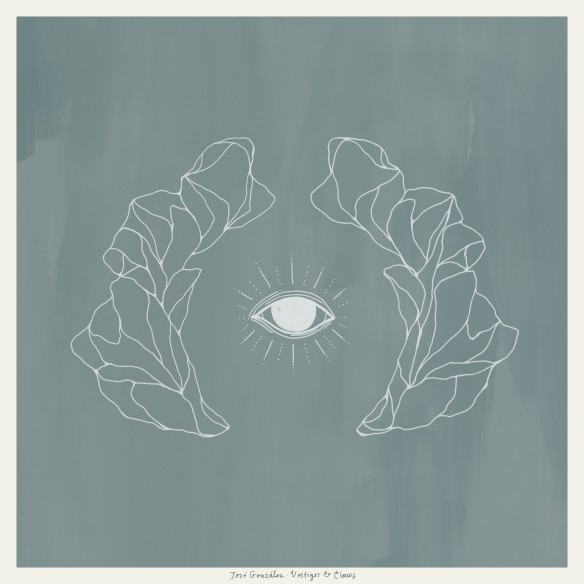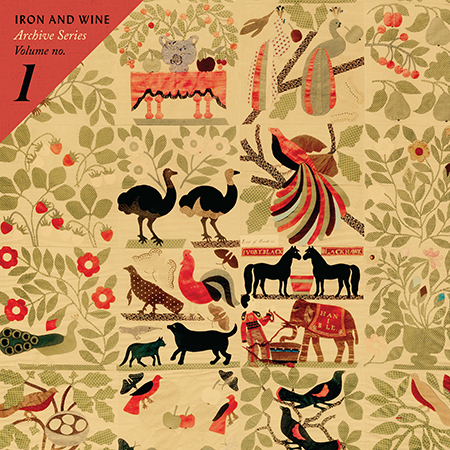Jose Gonzalez returns after hiatus with best work

Jose Gonzalez
“Vestiges & Claws”
(Mute)
The latest album from Swedish-Argentine Jose Gonzalez was partly produced by himself in his kitchen and the intimacy is felt throughout “Vestiges & Claws.” Across 10 arresting tracks, Gonzalez plays his acoustic guitar with a graceful tranquility considering “what it’s all about” in his aching tenor.
His voice is at once fervid and fragile, and like Arthur Russell or Yo La Tengo’s Ira Kaplan, he often lightens his tone for emphasis. On lucid closer, “Open Book,” he stretches toward falsetto with the words, “I have so much left to give,” after whistling nonchalantly between the verses. On “Let It Carry You,” Gonzalez sings about loosening “built up tensions” over a rolling bass line and hand percussion.
A number of these songs have a pastoral air about them. Lead track “With the Ink of a Ghost” evokes the wistful, floral feel of Simon & Garfunkel. On “The Forest,” he looks through “landscapes blurred by rain” and asks: “Why didn‘t I see the forest on fire behind the trees?”
Subtle detours are pleasant surprises. The sand-swept “Stories We Build, Stories We Tell” sounds informed by the Tuareg band Tinariwen and the outskirts of the Saharan guitar scene. Whereas “Every Age” invokes the spirit of Woody Guthrie with its intent to “build a place where we all can belong.’‘
Gonzalez’s politics are grounded in humanism. His compassion on this pointedly titled album, his first since 2007, is palpable.
Singer Steve Tyrell connects with his past on new CD

Steve Tyrell
“That Lovin’ Feeling”
(Concord)
“That Lovin’ Feeling” takes vocalist Steve Tyrell full circle to where he began his professional musical career as a producer-promoter for Scepter Records. The label had offices in Broadway’s iconic Brill Building packed with the songwriting teams who created an enduring soundtrack for Baby Boomers.
These connections make this the most personal and engaging of the 11 albums Tyrell has recorded since launching a second career as a jazz vocalist in 1999.
Singing with his appealing raspy twang, Tyrell offers jazzy arrangements of tunes from the early ’60s he considers the Great American Songbook Vol. 2, such as Carole King and Gerry Goffin’s “Up on the Roof” and Barry Mann and Cynthia Weil’s “Good Good Lovin’.”
What sets this tribute apart is that Tyrell can bring in many of the original artists as guests, including songwriter Mike Stoller, who plays Hammond B3 organ on his own “Stand By Me.”
Highlights include “You’ve Lost That Lovin’ Feelin’,” a soulful duet with surviving Righteous Brother Bill Medley; a saxophone-driven jazz arrangement of “Laughter in the Rain,” performed with composer Neil Sedaka; and “Rock and Roll Lullaby,” featuring singer B.J. Thomas, whom Tyrell produced on the original Scepter recording.
Tyrell is able to put his own stamp on these new standards, particularly on the girl group song “Chapel of Love,” which he sings from a male perspective in an arrangement featuring vocals from his daughter, Lauryn.
Iron & Wine releases choice archive material

Iron & Wine
“Archive Series Volume No. 1”
(Black Cricket Recording Co.)
The songs from Iron & Wine’s first album, “The Creek Drank the Cradle,” were cherry-picked from material Sam Beam had been recording at home for years before catching the attention of Sub Pop Records in 2002.
His first unreleased collection from that period, “Archive Series Volume No. 1,” acts as a companion piece to the debut. There is a banjo here, a flicker of female voice there, but this is mostly acoustic guitar with half the lyrics delivered just above a whisper.
The stunning “Eden” returns to the biblical imagery ingrained in some of his best work. At one point, Beam depicts heaven as “a distance not a place” and an indifference to destination and time recur throughout. There’s a lost watch; a calendar has fallen off the wall; and on “Beyond the Fence,” he sings: “This clock’s beautiful but can’t keep time.” The meditative pace frames inanimate details and lends these songs a timeless quality.
The constant is a clear Southern gothic character. There is mention of a sunburnt nose, ears of corn and a sheet blowing on a line. These are lived in songs about slow rivers, freckled girls and the shade of a dogwood tree. Personal songs - that in the hands of Beam -- are relatable.
(AP)

Jose Gonzalez
“Vestiges & Claws”
(Mute)
The latest album from Swedish-Argentine Jose Gonzalez was partly produced by himself in his kitchen and the intimacy is felt throughout “Vestiges & Claws.” Across 10 arresting tracks, Gonzalez plays his acoustic guitar with a graceful tranquility considering “what it’s all about” in his aching tenor.
His voice is at once fervid and fragile, and like Arthur Russell or Yo La Tengo’s Ira Kaplan, he often lightens his tone for emphasis. On lucid closer, “Open Book,” he stretches toward falsetto with the words, “I have so much left to give,” after whistling nonchalantly between the verses. On “Let It Carry You,” Gonzalez sings about loosening “built up tensions” over a rolling bass line and hand percussion.
A number of these songs have a pastoral air about them. Lead track “With the Ink of a Ghost” evokes the wistful, floral feel of Simon & Garfunkel. On “The Forest,” he looks through “landscapes blurred by rain” and asks: “Why didn‘t I see the forest on fire behind the trees?”
Subtle detours are pleasant surprises. The sand-swept “Stories We Build, Stories We Tell” sounds informed by the Tuareg band Tinariwen and the outskirts of the Saharan guitar scene. Whereas “Every Age” invokes the spirit of Woody Guthrie with its intent to “build a place where we all can belong.’‘
Gonzalez’s politics are grounded in humanism. His compassion on this pointedly titled album, his first since 2007, is palpable.
Singer Steve Tyrell connects with his past on new CD

Steve Tyrell
“That Lovin’ Feeling”
(Concord)
“That Lovin’ Feeling” takes vocalist Steve Tyrell full circle to where he began his professional musical career as a producer-promoter for Scepter Records. The label had offices in Broadway’s iconic Brill Building packed with the songwriting teams who created an enduring soundtrack for Baby Boomers.
These connections make this the most personal and engaging of the 11 albums Tyrell has recorded since launching a second career as a jazz vocalist in 1999.
Singing with his appealing raspy twang, Tyrell offers jazzy arrangements of tunes from the early ’60s he considers the Great American Songbook Vol. 2, such as Carole King and Gerry Goffin’s “Up on the Roof” and Barry Mann and Cynthia Weil’s “Good Good Lovin’.”
What sets this tribute apart is that Tyrell can bring in many of the original artists as guests, including songwriter Mike Stoller, who plays Hammond B3 organ on his own “Stand By Me.”
Highlights include “You’ve Lost That Lovin’ Feelin’,” a soulful duet with surviving Righteous Brother Bill Medley; a saxophone-driven jazz arrangement of “Laughter in the Rain,” performed with composer Neil Sedaka; and “Rock and Roll Lullaby,” featuring singer B.J. Thomas, whom Tyrell produced on the original Scepter recording.
Tyrell is able to put his own stamp on these new standards, particularly on the girl group song “Chapel of Love,” which he sings from a male perspective in an arrangement featuring vocals from his daughter, Lauryn.
Iron & Wine releases choice archive material

Iron & Wine
“Archive Series Volume No. 1”
(Black Cricket Recording Co.)
The songs from Iron & Wine’s first album, “The Creek Drank the Cradle,” were cherry-picked from material Sam Beam had been recording at home for years before catching the attention of Sub Pop Records in 2002.
His first unreleased collection from that period, “Archive Series Volume No. 1,” acts as a companion piece to the debut. There is a banjo here, a flicker of female voice there, but this is mostly acoustic guitar with half the lyrics delivered just above a whisper.
The stunning “Eden” returns to the biblical imagery ingrained in some of his best work. At one point, Beam depicts heaven as “a distance not a place” and an indifference to destination and time recur throughout. There’s a lost watch; a calendar has fallen off the wall; and on “Beyond the Fence,” he sings: “This clock’s beautiful but can’t keep time.” The meditative pace frames inanimate details and lends these songs a timeless quality.
The constant is a clear Southern gothic character. There is mention of a sunburnt nose, ears of corn and a sheet blowing on a line. These are lived in songs about slow rivers, freckled girls and the shade of a dogwood tree. Personal songs - that in the hands of Beam -- are relatable.
(AP)
-
Articles by Korea Herald




![[Herald Interview] 'Amid aging population, Korea to invite more young professionals from overseas'](http://res.heraldm.com/phpwas/restmb_idxmake.php?idx=644&simg=/content/image/2024/04/24/20240424050844_0.jpg&u=20240424200058)













![[KH Explains] Korean shipbuilding stocks rally: Real growth or bubble?](http://res.heraldm.com/phpwas/restmb_idxmake.php?idx=652&simg=/content/image/2024/04/25/20240425050656_0.jpg&u=)

